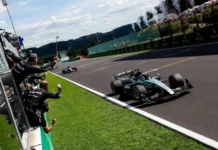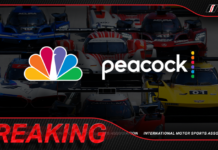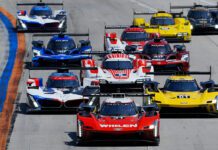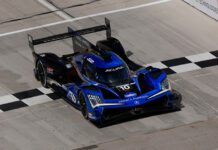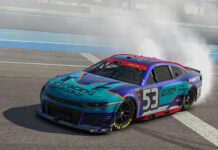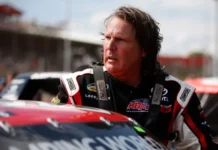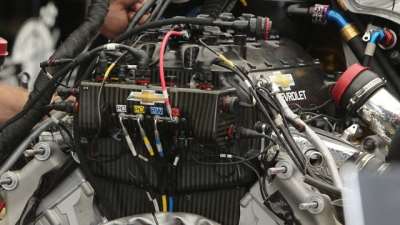Drawing from a successful season spent using a brand-new turbocharged engine formula, the IZOD IndyCar Series has made a few interesting changes to its 2013 engine regulations.
The series’ original set of engine regulations specified an itemized list of items that opened up for revisions and re-homologation after the first year of competition with the 2012 engines had been completed, with fuel systems as the biggest area of development to explore.
“As you know, direct injection (DI) was allowed this year and used by Honda and Chevrolet in addition to port injection,” said Trevor Knowles, director of engine development for the IndyCar Series.
“The rules allow the manufacturers to revise their fuel systems for 2013. I don’t know yet how much either of them intends to change, but Ilmor have said they want to re-homologate some parts for next year so I assume there will be some changes. Lotus ran only port injection and may make the switch for next year.”
(SPEED.com has confirmed that due to a lack of funding from Lotus in recent months, all engine development has ceased.)
With the rules allowing two fuel injectors per cylinder—one in the intake fuel port and one in the cylinder head for DI–Chevy and Honda made use of both out of necessity.

Due to the fixed location of each injector, and the need to flow a high volume of fuel through small-displacement engines turning 12,000 RPMs, relying 100 percent on the more efficient burn that the DI injectors offer wasn’t an option.
Proper feeding of each cylinder also meant the less efficient port injector had to be used, but with more than a year of data to draw from, IndyCar’s engine builders are now hard at work devising the best ways to improve consumption rates and make more power with new fuel systems.
“Because we are going to be allowed to run both DI and high-pressure port injection, we will have to test it,” said Wayne Bennett, who oversees the championship-winning Chevy IndyCar program for engine builder Ilmor Engineering. “In theory, with targeting of the fuel stream there could be a performance gain with the high-pressure port injection, however, if gains can’t be realized then [those revisions] would not be pressed into action.”
Although the engine rules only allow for the new fuel systems to be pressed into service once the 2012 season ended, Bennett says the Chevy Ilmor team has been working continuously to find gains whenever possible.
“Development is ongoing all year round and whether we have an off-season or not wouldn’t affect the planned development,” he remarked. “I think we would all rather be at a track racing for a longer period of time—a longer season–but as like I mentioned, it doesn’t affect development. As DI is a new technology to IndyCar racing, we have and will continue to try to exploit more gains from the system.” Knowles detailed the next major item that will be altered in the engine rules for next season.
“Regarding other changes to the technical rules, we will set the boost for road and street courses at 150kPa (21.75 PSI) with 160kPa (23.2 PSI) available during push-to-pass events,” he said. “That’s how we ended up this year but we wanted to formalize it for next year. The push-to-pass software may be changed to a set number of pushes rather than allowing the driver to turn it off and save it. That’s still under discussion.”
Asked if staying in that higher boost range for every type of circuit the series visits would be feasible (INDYCAR limits as little as 18.8 PSI for the Indy 500, for example), Bennett says more boost at every round would drive up costs through increased engine wear.
“As development continues this could be improved, but we also have to consider the durability of the engine and the fact that the mileage limits are going to continue to increase.”
Bennett touched on the last change to the 2013 engine regulations, noting the slight increase in minimum mileage each engine must achieve before an approved change is made to install a fresh unit.
The original target number for 2012 was 2000 miles, but that threshold was relaxed slightly to 1850 miles when all of the engine builders struggled to reach 2000 miles without component failures.
As Chevy and Honda found increased reliability as the 15-round championship wore on, meeting the 1850-mile limit became more routine, which led the series to bump the minimum number back up to 2000 miles next year.
“It was the plan from the start to increment the mileage limit and the manufacturers are OK with it so we are going ahead,” Knowles confirmed.
Like his counterparts at Honda Performance Development, Bennett and the Chevy Ilmor team have every intention of reaching the rebuild threshold on a more consistent basis next year, but won’t be surprised if a few curve balls are thrown their way.
“We continue to develop all the time and goal is more performance, fuel economy and durability,” he said. “Following the 2012 season we now have a certain amount of confidence in the durability engine.
“However as we increase performance and push the engine harder, we will undoubtedly uncover other durability concerns that will need addressing.”
Along with the limited number of items the engine manufacturers are allowed to change at will, new connecting rods and bushings are a open to a one-time redesign for 2013. (speed)







